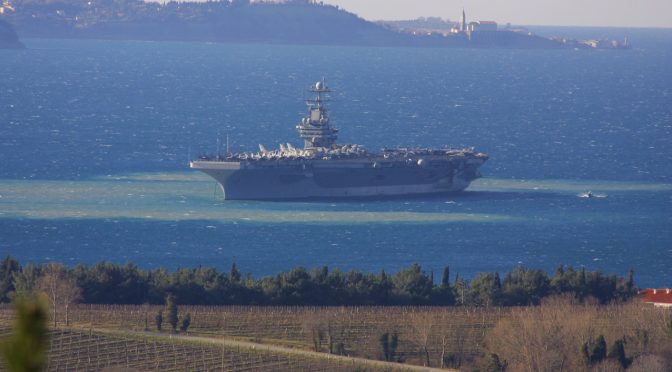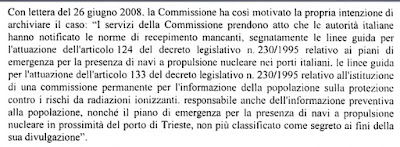US nuclear air carrier on the maritime border Slovenia/Free Territory of Trieste (Municipality of Muggia)
Among the many elements of the illegal simulation of sovereignty that the provisional Italian administering authorities of the present-day Free Territory of Trieste defend more and more desperately, there certainly is the question of the title with which Italian armed forces (but not only the Italian ones…) can act in a State that, according to under article 3 of Annex VI of the 1947 Treaty of Peace, should be “demilitarised and neutral”.
In the same “demilitarised and neutral” State, Annex VIII of the same Treaty establishes an international Free Port, the only one in the world, as a State corporation of the Free Territory of Trieste, under the control of an International Commission consisting in representatives from more than 20 States. This means the Treaty created a real economic zone for the freights, enterprises and governments of all States in the world, however, it results that the same port does also host not only ships of the Italian Military Navy, but is also registered as nuclear port of the NATO.
At first sight, such elements might appear as irremediable contradictions (and the silence of the administering Italian authorities, who are also guilty of extending Italian military service to the present-day FTT does not help that – LINK), so the only way to understand this confused, factual situation is to analyse the situation de jure.
Let us move back to article 3 of Annex VI: “No armed forces, except upon direction of the Security Council, shall be allowed in the Free Territory” because the UNSC is the international guarantor of the integrity and independence of the Free Territory of Trieste by virtue of its own Resolution S/RES/16 (1947) and of the Treaty of Peace itself (article 21).
Why this clause? Easy: after the independence of Trieste and of its territory, on September 15th, 1947 (the date of the coming into force of the Treaty of Peace) the role of first Government of the new State was entrusted to Allied armed forces already present in the area which, as for the present-day FTT, were the British-US Troops of the AMG FTT (Allied Military Government Free Territory of Trieste) which means, to the Governments of the United States and of the United Kingdom.
The mandate entrusted to the AMG FTT was a special trusteeship, which should have lasted only until the appointment of the Governor of the Free Territory of Trieste by the UNSC itself.
However, the tensions of the Cold War prevented the appointment of the Governor of the Free Territory of Trieste within the short terms expected by the Treaty of Peace, and the administration of the AMG FTT lasted from 1947 to 1954: during that time, the city was reconstructed and its port played a key role in the supply of Central Europe, especially in the transport of US aid for European Reconstruction (Marshall Plan).
Everything changed in 1954, when the Governments of the United States and of the United Kingdom handed over to the Italian Government (not to the Italian State) the temporary civil administration over the present-day FTT. So, since 1954, the Italian Government has also a second role: the role of temporary civil government of the Free Territory of Trieste, which it exercises to our days through a Commissar, established with the same Italian law that established Autonomous Region Friuli Venezia Giulia (article 70).
The ultimate evidence of this is that Italian Constitutional Law 1/1963 is in force in the Free Territory of Trieste only by virtue of its publication on the Official Bulletin of the General Commissioner of the Italian Governor for the Territory of Trieste No. 7 of March 11th, 1963.
This is the situation de iure, buried under decades of nationalistic propaganda of State and violations that Free Trieste is now denouncing and disproving thanks to no less but laws in force.
Now let us return to the presence of military forces in the Free Territory of Trieste: the mandate entrusted to the Governments of the United Kingdom and of the United States revolved on more than civil administration alone (which they sub-entrusted to the Italian Government in 1954), including also the military defence of the new State and of its international Free Port. This decision makes sense, on the other side, not just because of the tensions of the Cold War, but because of the notorious attempts of certain Italian circles to annex the whole FTT with a military coup (LINK).
It is also for this reason the the military defence of the Free Territory of Trieste could not be sub-entrusted to others but to an international organization without conflicts of interest: the NATO. This is the reason why the international Free Port of the Free Territory of Trieste is also a military nuclear port. And so, when they are in Trieste, Italian armed forces are not representing the Republic of Italy, but NATO.
Only, the Italian administering authorities have hidden those details: not really out of fear for the people of Trieste, rather, out of fear that some of the signatories of the Treaty of Peace that does no belong to NATO (maybe Russia or China, both UNSC permanent members…) requested explanations about the titles with which NATO is active in Trieste, and possibly receiving the proper answers of the United States and of the United Kingdom (who are as well permanent members of the Security Council).
Such a “scandal” would have redundantly destroyed all lies about the “return of Trieste to Italy” which are important not really for sentimental reasons, but for economic purposes: not only the international Free Port of Trieste is a competitor of Italian Ports, but if the citizens of Trieste had discovered how they civil, economic, and political rights were trampled on for decades, they might have demanded the proper reparation…
And this is why the status of the nuclear Port of Trieste was only discovered in 2003, due to the complaints presented by me to the European Commission, denouncing the lack of the External Emergency Plan of the nuclear port of Trieste (I have told this story in detail in investigative book “Tracks of Legality – how Italian mafias and corruptions pollute the Free Territory of Trieste”).
To that moment, the Prefect Office (and Office of the Commissioner of the Government) inTrieste refused to made the document public, even it that represented the base to prevention in case of radiologic emergency. The reason is simple: there was no E.E.P. for the nuclear Port of Trieste.
Because the very drafting of an E.E.P. would have given raise to inconvenient questions about the international Free Port of Trieste (which, again, is a corporation of State of the Free Territory of Trieste) and could have revealed the common source of the mandates of the Italian Government and of the NATO. This is why the non-existent E.E.P. was “classified” and therefore made unavailable to the citizens, making it impossible to them to face a nuclear emergency.
But facing an infringement procedure of the European Union, Italy had to give up, drafting the E.E.P. of the nuclear Port of Trieste and making it public, even if with all possible limitations.
It happened in 2007. For the first time, document that were classifies under “secret” became of public domain, and someone started asking inconvenient questions about the international status of the Free Port of Trieste.
This was an important step for many more actions, from the opposition to Spanish multinational company’s LNG terminal in the Free Port of Trieste (LINK) to the legal actions preventing the illegal attempt to urbanise its northern sector (LINK). And it still is the base of the actual re-establishment of the legal status that international treaties grant to Trieste and to its extraordinary port.
The present-day Free Territory of Trieste cannot return to legality as long as its international Port continues to be hostage of the interests of certain States and classified as a military nuclear port.
The opinion of the European Commission on the Nuclear Port of Trieste (above)
Translation by Silvia Verdoglia
Links – in Italian – to understand the radiological emergency in the Free Territory of Trieste (from the website of Greenaction Transnational, soon available in English):



